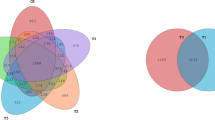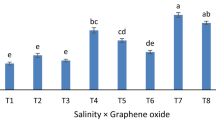Abstract
Changbai larch (Larix olgensis A. Henry) seedlings growing in a Haplic Cambisol and receiving 0 (Ck), 25, 50, 100, 250, or 500 mg L−1 graphene oxide (GO) were incubated for 30, 40, or 50 days, and the effects of applying GO on the growth and physiological characteristics of the seedlings and soil chemical properties and enzyme activities were investigated. The superoxide anion (except for 25 mg L−1 at 40 days and 50 mg L−1 at 50 days) and hydrogen peroxide contents of the leaves increased at 25–100 mg L−1 GO; however, superoxide dismutase (SOD) and peroxidase (POD) (except for 100 mg L−1 at 50 days) activities, soluble protein (except for 100 mg L−1 at 30 and 40 days), proline (except for 100 mg L−1 at 50 days), as well as seedling biomass (except for stems at 25–100 mg L−1, and leaves and roots at 50–100 mg L−1 for 30 days) all decreased. However, when the seedlings were exposed to 250–500 mg L−1 GO, especially at 40 and 50 days, these trends for tree growth and physiological parameters were reversed, suggesting the beneficial effect of GO at high concentrations on the seedlings. GO decreased the organic matter, alkali-hydrolyzale nitrogen, available phosphorus, and potassium contents of the soil at 40 and 50 days (except for available phosphorus at 50 days), as well as the acid phosphatase, urease (except for 30 days), dehydrogenase, and catalase activities (except for 30 and 40 days); thus, GO may inhibit nitrogen and phosphorus cycling in Haplic Cambisols (except for nitrogen at 30 days).











Similar content being viewed by others
Data availability
The raw data required to reproduce these findings cannot be shared at this time as the data also forms part of an ongoing study.
References
Ahmed F, Rodrigues DF (2013) Investigation of acute effects of graphene oxide on wastewater microbial community: a case study. J Hazard Mater 256:33–39
Badiane NNY, Chotte JL, Patea E, Masse D, Rouland C (2001) Use of soil enzyme activities to monitor soil quality in natural and improved fallows in semi-arid tropical regions. Appl Soil Ecol 18:229–238
Baligar VC, Wright RJ, Smedley MD (1988) Acid phosphatase activity in soils of the Appalachian region. Soil Sci Soc Am J 52:1612–1616
Becerril HA, Mao J, Liu ZF, Stoltenberg RM, Bao ZN, Chen YS (2008) Evaluation of solution-processed reduced graphene oxide films as transparent conductors. ACS Nano 2:463–479
Belyaeva ON, Haynes RJ, Sturm EC (2012) Chemical, physical and microbial properties and microbial diversity in manufactured soils produced from co-composting green waste and biosolids. Waste Manag 32:2248–2257
Chen LX (2005) Soil experiment and practice course. Northeast Forestry University Press, Harbin, pp 61–95
Compton OC, Nguyen SBT (2010) Graphene oxide, highly reduced graphene oxide, and graphene: versatile building blocks for carbon-based materials. Small 6:711–723
Dreyer DR, Park S, Bielawski CW, Ruoff RS (2009) The chemistry of graphene oxide. Chem Soc Rev 39:228–230
Fan HL, Hong W, Wu CZ, Chen C, Li J (2012) Effects of water stress on the physiological indexes of carbon and nitrogen metabolization of Liriope muscari (Decne.) Bailey. J Fujian Agric For Univ (Nat Sci Ed) 41:454–458
Gao FQ, Liu C, Qu CX, Zheng L, Yang F, Su MY, Hong FH (2008) Was improvement of spinach growth by nano-TiO2 treatment related to the changes of Rubisco activase. Biometals 21:211–217
Ghosh M, Bandyopadhyay M, Mukherjee A (2010) Genotoxicity of titanium dioxide (TiO2) nanoparticles at two trophic levels: plant and human lymphocytes. Chemosphere 81:1253–1262
Häussling M, Marschner H (1989) Organic and inorganic soil phosphates and acid phosphatase activity in the rhizosphere of 80-year-old Norway spruce [Picea abies (L.) karst.] trees. Biol Fertil Soils 8:128–133
He CL, Gao F, Lu XX, Hou Z, Zhan S (2012) Ecotoxicological effects of multi-wall carbon nanotube on soil microorganisms. Asian J Ecotoxicol 7:155–161
He YJ, Hu RR, Zhong YJ, Zhao XL, Chen Q, Zhu HW (2018) Graphene oxide as a water transporter promoting germination of plants in soil. Nano Res 11:1928–1937
Hegab HM, Zou L (2015) Graphene oxide-assisted membranes: fabrication and potential applications in desalination and water purification. J Membr Sci 484:95–106
Hoffmann G, Teicher K (2010) Ein kolorimetrisches verfahren zur bestimmung der ureaseaktivität in Böden. J Plant Nutr Soil Sci 95:55–63
Hu CW, Liu L, Li XL, Xu YD, Ge ZG, Zhao YJ (2017) Effect of graphene oxide on copper stress in Lemna minor L.: evaluating growth, biochemical responses, and nutrient uptake. J Hazard Mater 341:168–176
Hu X, Mu L, Wen J, Zhou Q (2012) Covalently synthesized graphene oxide-aptamer nanosheets for efficient visible-light photocatalysis of nucleic acids and proteins of viruses. Carbon 50:2772–2781
Hu XG, Lu KC, Mu L, Kang J, Zhou QX (2014) Interactions between graphene oxide and plant cells: regulation of cell morphology, uptake, organelle damage, oxidative effects and metabolic disorders. Carbon 80:665–676
Jin L (2013) High concentrations of single-walled carbon nanotubes lower soil enzyme activity and microbial biomass. Ecotox Environ Safe 88:9–15
Johnson JL, Temple KL (1964) Some variables affecting the measurement of “catalase activity” in soil. Soil Sci Soc Am J 28:207–209
Khodakovskaya M, Dervishi E, Mahmood M, Xu Y, Li ZR, Watanabe F, Biris AS (2012) Carbon nanotubes are able to penetrate plant seed coat and dramatically affect seed germination and plant growth. ACS Nano 6:3221–3227
Li LN, Teng Y, Ren WJ, Li ZG, Luo YM (2016) Effects of graphene on soil enzyme activities and microbial communities. Soils 48:102–108
Li ZM, Song ZL, Parr JF, Wang HL (2013) Occluded C in rice phytoliths: implications to biogeochemical carbon sequestration. Plant Soil 370:615–623
Lin D, Xing B (2007) Phytotoxicity of nanoparticles: inhibition of seed germination and root growth. Environ Pollut 150:240–250
Matorin DN, Todorenko DA, Seifullia NK, Zayadan BK, Rubin AB (2013) Effect of silver nanoparticles on the parameters of chlorophyll fluorescence and P-700 reaction in the green alga Chlamydomonas reinhardtii. Microbiology 82:809–814
Pan Y, Sahoo NG, Li L (2012) The application of graphene oxide in drug delivery. Expert Opin Drug Del 9:1365–1376
Paredes JI, Villar-Rodil S, Martínez-Alonso A, Tascón JMD (2008) Graphene oxide dispersions in organic solvents. Langmuir 24:10560–10564
Ren W, Mura S, Irudayaraj JMK (2015) Modified graphene oxide sensors for ultra-sensitive detection of nitrate ions in water. Talanta 143:234–239
Sadiq IM, Dalai S, Chandrasekaran N, Mukherjee A (2011) Ecotoxicity study of titania (TiO2) NPs on two microalgae species: Scenedesmus sp. and Chlorella sp. Ecotox Environ Safe 74:1180–1187
Shakoor MB, Ali S, Hameed A, Farid M, Hussain S, Yasmeen T, Najeeb U, Bharwana SA, Abbasi GH (2014) Citric acid improves lead (Pb) phytoextraction in Brassica napus L. by mitigating Pb-induced morphological and biochemical damages. Ecotox Environ Safe 109:38–47
Shrestha B, Martinezb VA, Cox SB, Green MJ, Li S, Cañas-Carrell JE (2013) An evaluation of the impact of multiwalled carbon nanotubes on soil microbial community structure and functioning. J Hazard Mater 261:188–197
Song JF, Ma R, Huang WB, Yang D, Cui XY (2014) Exogenous organic acids protect Changbai larch (Larix olgensis) seedlings against cadmium toxicity. Fresenius Environ Bull 23:3459–3467
Stampoulis D, Sinha SK, White JC (2009) Assay-dependent phytotoxicity of nanoparticles to plants. Environ Sci Technol 43:9473–9479
Szabó T, Berkesi O, Forgó P, Josepovits K, Sanakis Y, Petridis D, Dékány I (2006) Evolution of surface functional groups in a series of progressively oxidized graphene oxides. Chem Mater 18:2740–2749
Tang YL, Tian JL, Li SY, Xue CH, Xue ZH, Yin DQ, Yu SL (2015) Combined effects of graphene oxide and Cd on the photosynthetic capacity and survival of Microcystis aeruginosa. Sci Total Environ 532:154–161
Teng Y, Luo YM, Li ZG (2006) Microbial diversity in polluted soils: an overview. Acta Pedol Sin 43:1018–1026
Tong Z, Bischoff M, Nies L, Applegate B (2007) Impact of fullerene (C60) on a soil microbial community. Environ Sci Technol 41:2985–2991
Wang K, Ruan J, Song H, Zhang JL, Wo Y, Guo SW, Cui DX (2011) Biocompatibility of graphene oxide. Nanoscale Res Lett 6:8–10
Wang XP, Han HY, Liu XQ, Gu XX, Chen K, Lu DL (2012) Multi-walled carbon nanotubes can enhance root elongation of wheat (Triticum aestivum) plants. J Nanopart Res 14:841
Wei HM (2015) Effect of graphene oxide on germination and growth of seedlings in crops. Dissertation. Yangtze University, Jingzhou
Wu JH, Jiao JZ, Xie LL, Yuan CF, Chen F, Xu BB (2015) Effects of graphene oxide on growth and development of Brassica napus L. Genomics Appl Biol 34:2738–2742
Yan J, Han XZ, Ji ZJ, Li Y, Wang ET, Xie ZH, Chen WF (2014) Abundance and diversity of soybean-nodulating rhizobia in black soil are impacted by land use and crop management. Appl Environ Microbiol 80:5394–5402
Yin LY, Wang Z, Wang SG, Xu WY, Bao HF (2018) Effects of graphene oxide and/or Cd2+ on seed germination, seedling growth, and uptake to Cd2+ in solution culture. Water Air Soil Pollut 229:151
Zhang C, Chen XF, Zhou B, Zhang CL, Li JJ, Zhang J, Dai J (2014) Effects of vermicompost on microbial characteristics and enzyme activities in soil. Soils 46:70–75
Zhang XY, Yin JL, Peng C, Hu WQ, Zhu ZY, Li WX, Fan CH, Huang Q (2011) Distribution and biocompatibility studies of graphene oxide in mice after intravenous administration. Carbon 49:986–995
Zhao SQ, Wang QQ, Zhao YL, Rui Q, Wang DY (2015) Toxicity and translocation of graphene oxide in Arabidopsis thaliana. Environ Toxicol Pharmacol 39:145–156
Zhu YW, Murali S, Cai WW, Li XS, Suk JW, Potts JR, Ruof RS (2010) Graphene and graphene oxide: synthesis, properties, and applications. Adv Mater 22:3906–3924
Funding
This work was financially supported by the National Natural Science Foundation of China (31370613) and the Fundamental Research Funds for the Central Universities (2572019CP15).
Author information
Authors and Affiliations
Contributions
Conceptualization, J.S. and X.C. Data curation, N.L., Y.S., and C.D. Investigation, N.L. and C.D. Project administration, J.S. Writing—original draft, J.S., and C.D. Writing—review and editing, Y.S. and X.C.
Corresponding author
Ethics declarations
Competing interests
The authors declare no conflict of interest.
Ethical approval
Not applicable.
Consent to participate
Not applicable.
Consent to publish
All authors have reviewed the final version of the manuscript and approved it for publication.
Additional information
Responsible Editor: Gangrong Shi
Publisher’s note
Springer Nature remains neutral with regard to jurisdictional claims in published maps and institutional affiliations.
Rights and permissions
About this article
Cite this article
Song, J., Luo, N., Sang, Y. et al. Graphene oxide affects growth and physiological indexes in Larix olgensis seedlings and the soil properties of Haplic Cambisols in Northeast China. Environ Sci Pollut Res 28, 20869–20882 (2021). https://doi.org/10.1007/s11356-020-11972-w
Received:
Accepted:
Published:
Issue Date:
DOI: https://doi.org/10.1007/s11356-020-11972-w




